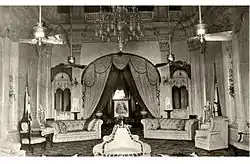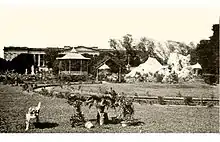24°10′58″N 88°16′10″E / 24.182663°N 88.269492°E
| Wasif Manzil | |
|---|---|
 An old photo of the palace's drawing room with Nawab Wasif Ali Mirza Khan picture at the back. | |
| Alternative names | New Palace |
| General information | |
| Location | West Bengal |
| Town or city | Murshidabad |
| Country | India |
| Completed | Present building was completed in 1904 after the earthquake. |
| Renovated | Renovations were done after the 1897 earthquake. Currently maintenance is done by the Archaeological Survey of India. |
| Destroyed | 1897 earthquake |
| Technical details | |
| Floor count | Present Building is a ground floor building with a terrace. The former building was a two storied palace. |
| Design and construction | |
| Architect(s) | Mr. Vivian, officer of the Public Works Department of the Nadia Rivers Division and Surendra Barat, a Bengali engineer. |
| Website | |
| "Website URL". | |
Wasif Manzil (also known as Wasef Manzil and New Palace) was built by Nawab Wasif Ali Mirza Khan under the direction and supervision of Mr. Vivian, officer of the Public Works Department of the Nadia Rivers Division and Surendra Barat, a Bengali engineer. This building, rather palace was used by the Nawab as his residence. The building is extremely close to the Hazarduari Palace. It is built on the Nizamat Fort Campus between the campus's Dakshin Darwaza (south gate) and the Hazarduari Palace, just opposite the campus's South Zurud Mosque and parallel to the Bhāgirathi-Hooghly River.
Geography
F: facility, H: historical site
Owing to space constraints in the small map, the actual locations in a larger map may vary slightly
Location
Wasif Manzil is located at 24°10′58″N 88°16′10″E / 24.182663°N 88.269492°E.
Hazarduari Palace and its associated sites in the Kila Nizamat area (forming the central area in the map alongside) is the centre of attraction in Murshidabad. Just a little away are Katra Masjid, Fauti Mosque, Jama Masjid and the Motijhil area. There is a group of attractions in the northern part of the town (as can be seen in the map alongside). Some attractions such as Khushbagh, Rosnaiganj, Baranagar, Kiriteswari Temple, Karnasuvarna and others are on the other side of the river and there are attractions in the neighbouring Berhampore area also (not shown in the map).[1]
Note: The map alongside presents some of the notable locations in Murshidabad city. Most of the places marked in the map are linked in the larger full screen map. A few, without pages yet, remain unmarked. The map has a scale. It will help viewers to find out the distances.
Destruction

The palace was extensively destroyed in the 1897 earthquake on 12 June. The whole of the palace's second storey came down within a few seconds. It was repaired later but without the second storey. Adjacent to the palace was an artificial hill and a landscape garden which now cease to exist.
Features
The palace has been designed to look a little like a castle with small corner turrets on the corners. The palace has a semi-circular pediment with the Nawabs of Murshidabad's coat of arms on it. Now, the palace is maintained by the Archaeological Survey of India and has been transformed into a museum. The palace has a garden space in front of it which has a fountain and several marble statues. The garden space is enclosed with a handsome iron railing. The main entrance is a Norman archway with open-work iron doors. The staircases and statues inside the palace are also made of marble and are worth seeing.
Wasif Manzil picture gallery
 Wasif Manzil
Wasif Manzil Wasif Manzil
Wasif Manzil Statue
Statue Coat of Arms - stucco decoration
Coat of Arms - stucco decoration Wasif Manzil
Wasif Manzil
See also
- Nizamat Fort Campus and other buildings built in the campus:
- Nawab Wasif Ali Mirza Khan, the Nawab who built this majestic palace.
- Nawabs of Bengal and Murshidabad
References
- ↑ "Offbeat Weekend in Murshidabad". Outskirts of Killa Nizamat (Northern part). Offbeat Weekend. Retrieved 20 July 2021.